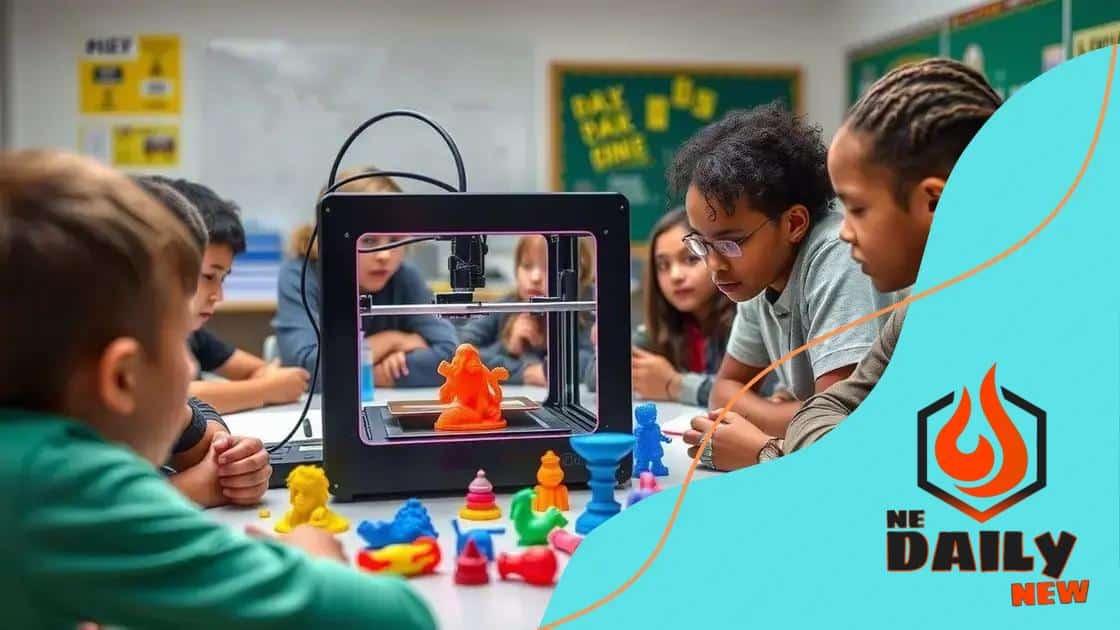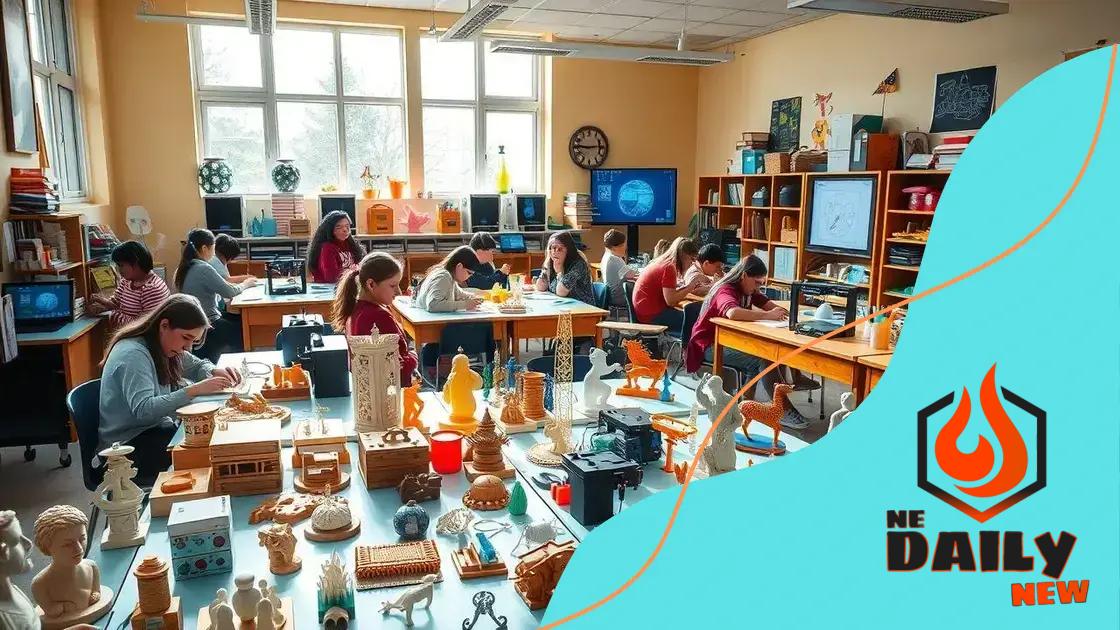The impact of 3D printing in hands-on education

The impact of 3D printing in hands-on education enhances creativity, problem-solving skills, and collaboration, offering students innovative and interactive learning experiences across various subjects.
The impact of 3D printing in hands-on education is reshaping how students interact with learning materials. Have you ever imagined designing an object and bringing it to life in the classroom? This technology opens up endless possibilities for creativity and real-world applications.
What is 3D printing in education?
3D printing in education is an exciting way to enhance learning. It allows students to create physical objects from digital designs. This technology brings concepts to life, making lessons more engaging.
How does 3D printing work?
Using a computer, students can design 3D models with software. These designs are then sent to a 3D printer, which layers materials like plastic to create the object. This process not only teaches students about technology but also boosts their creativity and problem-solving skills.
Benefits for students
- Encourages creativity: Students can visualize and bring their ideas to life.
- Enhances understanding: Complex subjects become easier to grasp when you can see and touch them.
- Boosts engagement: Hands-on activities make learning fun and memorable.
Moreover, 3D printing fosters collaboration among students. They often work in teams to design and create their projects. This teamwork enhances communication skills and builds confidence.
Additionally, integrating 3D printing into the curriculum prepares students for future careers. Many industries are using this technology, from healthcare to manufacturing. By learning 3D printing, students gain valuable skills that are in high demand.
In summary, the use of 3D printing in education not only makes learning interactive but also equips students with essential skills for their future. This innovative approach transforms traditional classrooms into dynamic environments.
Benefits of hands-on learning with 3D printing
Hands-on learning with 3D printing offers many valuable advantages for students. It creates an active learning environment where students can explore, design, and create. This type of learning engages students in a way that traditional methods can’t.
Encouraging creativity
When students engage with 3D printing, they can express their ideas and bring them to life. This process helps them think outside the box and innovate. Being able to physically create a model encourages them to take risks and experiment with their designs.
Improving problem-solving skills
Through hands-on projects, students face challenges that require critical thinking. They learn to analyze problems and come up with solutions. This practice in real-world scenarios prepares them for future challenges in life and work.
- Students learn to modify designs based on feedback.
- They develop resilience by overcoming obstacles in their projects.
- Critical thinking is enhanced as they troubleshoot issues that arise.
Moreover, hands-on learning fosters collaboration among peers. Students often work in teams to complete projects, sharing ideas and skills. This teamwork helps build social skills and prepares them for group work in their future careers.
Integrating 3D printing into education also boosts student motivation. Seeing a physical representation of their ideas can be incredibly rewarding. It cultivates a sense of achievement and pride in their work.
Overall, the benefits of hands-on learning with 3D printing are profound. By encouraging creativity, problem-solving, collaboration, and motivation, this innovative approach makes learning enjoyable and effective.
Examples of 3D printing projects in schools

3D printing projects in schools open doors to creativity and innovation. Educators around the world are using this technology to create engaging learning experiences. Let’s explore a few exciting examples that highlight the potential of 3D printing in education.
Creating Models of Historical Artifacts
Students can design and print models of historical artifacts. This project allows them to explore different cultures and understand history hands-on. By interacting with these models, they deepen their knowledge and appreciation for the past.
Engineering Challenges
Schools often host engineering challenges where students need to design and print functional objects. For example, they might create structures that can support weight or bridges that can span a certain distance. These challenges develop problem-solving skills and encourage teamwork.
- Students design their own blueprints before printing.
- They test and modify their designs to improve performance.
- Collaboration fosters teamwork and communication skills.
Another interesting project involves creating custom tools or aids. For instance, students can design assistive devices like grips for the disabled. This project teaches empathy and social responsibility while utilizing technology for real-world solutions.
Art classes also benefit from 3D printing. Students can create sculptures or intricate designs, bringing their artistic vision to life. This not only enhances their artistic skills but also exposes them to new mediums and technologies.
As you can see, the possibilities for 3D printing projects in schools are vast, offering enriching experiences that foster a love for learning.
Challenges faced in integrating 3D printing
Integrating 3D printing into education comes with its own set of challenges. While the benefits are clear, there are obstacles that educators and schools must navigate to make the most of this technology.
Costs and Funding
One major challenge is the cost associated with acquiring 3D printers and the materials needed for printing. Many schools operate on tight budgets, making it hard to allocate funds for new technology. Finding financial support or grants can be a daunting task.
Training and Support
Another issue is the need for proper training and support for teachers. Not all educators are familiar with 3D printing technology. They need training to effectively incorporate it into their lessons. Schools should provide ongoing support to ensure teachers feel confident using these tools.
- Workshops and professional development can help educators improve skills.
- Collaboration with local businesses or universities could provide additional resources.
- Online tutorials and communities can offer valuable tips and advice.
Technical difficulties can also arise during the printing process. Problems such as equipment malfunctions or issues with design software can disrupt lessons. It’s crucial for schools to have a plan in place to address these challenges as they occur.
Additionally, schools must find ways to fully integrate 3D printing into the curriculum. It cannot be just an add-on but should align with learning objectives. Teachers need to be creative in developing projects that incorporate this technology meaningfully.
Despite these challenges, the integration of 3D printing in education can lead to rewarding outcomes if approached strategically. By understanding and addressing these obstacles, schools can better prepare students for a technology-driven future.
Future trends of 3D printing in education
The future of 3D printing in education is bright and full of possibilities. As technology advances, it will continue to transform how students learn and create. Educators and students alike can look forward to new methods and applications that enhance education.
Increased Accessibility
One trend is the increased accessibility of 3D printing technology. As prices drop and more schools adopt this technology, students everywhere will have the opportunity to engage with it. This democratization of resources allows more learners to explore their creativity.
Enhanced Learning Experiences
With augmented reality (AR) and virtual reality (VR) combining with 3D printing, learning will become even more immersive. Imagine students being able to print and interact with 3D models of historical sites or biological structures. This approach brings subjects to life in exciting new ways.
- AR and VR can provide visual contexts to complex subjects.
- Students will engage more deeply with the material through interactive experiences.
- Collaboration across distances can become easier with shared virtual environments.
Furthermore, we can expect to see more interdisciplinary projects that incorporate 3D printing. Students from different subjects, such as science, art, and math, will collaborate on projects that blend knowledge from various fields. This fosters critical thinking and innovation.
Another critical trend is the use of 3D printing for sustainability. As schools explore eco-friendly materials and practices, students can learn about environmental responsibility. They will create products from recyclable materials, promoting a culture of sustainability.
Overall, the future trends of 3D printing in education promise enhanced learning experiences, enriched creativity, and greater collaboration. These advancements will help prepare students for a rapidly changing world.
FAQ – Frequently Asked Questions about 3D Printing in Education
How can 3D printing enhance creativity in the classroom?
3D printing allows students to bring their ideas to life by designing and creating physical objects, fostering innovation and creative thinking.
What are some examples of projects that use 3D printing in schools?
Examples include creating historical artifacts, engineering challenges, custom tools for accessibility, and artistic sculptures.
What challenges do schools face when integrating 3D printing?
Challenges include high costs, the need for proper teacher training, equipment maintenance, and aligning projects with curriculum objectives.
What is the future of 3D printing in education?
The future includes increased accessibility, enhanced learning experiences through AR/VR, interdisciplinary projects, and a focus on sustainability.





